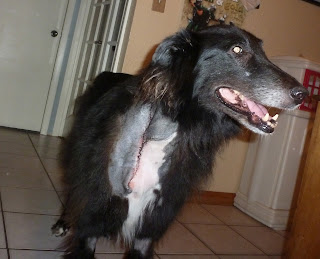When I decided to start this blog, I wanted to use cases I have seen at the hospital to help illustrate some interesting or important facts about pets. Unfortunately, one of the first examples will be my own dog, Max. It’s unfortunate because of the nature of his disease;
Max has cancer.
Max is such a good dog, and our family is scared. The possibility of losing anyone you love is always gut wrenching, no matter how many legs they have. I am hesitant to use him as an example, because it’s impossible to be objective about your own dog. I’ll try nonetheless.
 |
| Max |
Max has a soft tissue sarcoma near his right shoulder. We admittedly caught it later than we should have, because originally it was hidden beneath a lipoma, which is a benign fatty tumor. Sarcomas are malignant cancers, but they spread in a different way than what most of us think when we think of cancer.
Typically, when we think of a cancer in any individual, we think of a metastatic cancer. Metastatic cancers “jump around” the body by traveling through the bloodstream or lymph system. Similar to a dandelion flower, pieces of the cancer go sailing off and settle elsewhere in the body. These pieces can settle in lymph nodes, the lungs, the liver or anywhere depending on the type of cancer. Like dandelion seeds growing new plants, these metastases form new cancers where they settle.
Sarcomas tend to be locally invasive rather than metastatic. Instead of spreading like a dandelion flower, locally invasive cancers spread by sending out microscopic “tentacles” in all directions. It’s like a plant that could completely regrow from the tiniest piece of root. If you are trying to dig up such a plant, you would have to dig a huge hole around the stem, trying to get all the possible roots that you can not see beneath the surface. If you surgically try to remove a sarcoma, you need big margins around the outside if you want to have a chance of completely removing it.
The first time we tried to remove the tumor, two small invisible pieces were left behind and started growing again. His latest surgery was an attempt to remove it for good. His incision is about 11 inches long, with a second cut radiating out from the first. I had to cut out large pieces of muscle and skin, which is why the incision is oddly shaped. It was not a comfortable procedure, but he is on good pain medications and is recovering well; He is walking and eating well, just 48 hours after surgery.
Now comes the waiting part. We sent the tissue to a pathologist, and should hear back whether the “margins are clean” (free of cancer tissue.) With sarcomas, even with a good pathologist report, we will have to monitor the area carefully. The smallest piece can lead to a recurrence.
Are there other treatments besides surgery? Chemotherapy is usually not as effective for sarcomas as other types of cancer. Radiation therapy at a referral hospital does help, and my wife and I have been discussing that option as well.
Hopefully I will report back with good news soon.
Michael Rumore, DVM and Max's dad




No comments:
Post a Comment